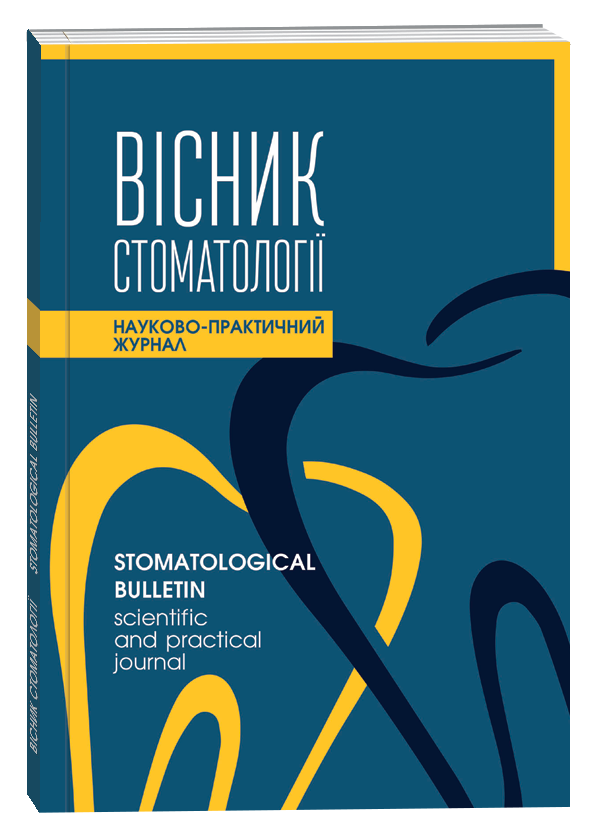BIOCHEMICAL PARAMETERS OF ORAL FLUID AS A CRITERION FOR ASSESSING THE STATE OF ANTIOXIDANT-PROOXIDANT SYSTEMS IN CHILDREN WITH MANIFESTATIONS OF GERD
DOI:
https://doi.org/10.35220/2078-8916-2020-38-4-96-101Keywords:
gastroesophageal reflux disease, children, endotoxicosis, treatment, oxidative stress, preventionAbstract
Gastroesophageal reflux disease (GERD) is one of the most common, potentially dangerous gastroenterological diseases, which, according to the World Health Organiza-tion (WHO), is considered a disease of the 21st century. According to the Ministry of Health of Ukraine, diseases of the gastrointestinal tract occupy one of the first places in the structure of children's somatic pathology and have a tendency to increase. Among the clinical manifestations of GERD in children, as well as in adults, esophageal and ectraesophageal symptoms are distinguished. The oral cavity is the beginning of the digestive tract, and its mu-cous membrane is an important integral component of the system of anatomical and physiological connections of the digestive tract. Saliva is one of the most important ele-ments responsible for the homeostasis of the oral cavity and gastrointestinal tract. Changes in the ratio of factors of local immunity of the oral cavity, in children against the background of GERD, in comparison with healthy children, plays a role in the onset and generalization of the inflammatory process in the periodontium. Not a sin-gle inflammatory process goes away without the devel-opment of endotoxicosis and oxidative stress; therefore, the study of markers of antioxidant protection is extreme-ly relevant.
The dynamics of the main markers of inflammation in the oral cavity was investigated, in particular: the activity of elastase, catalase and the content of the end product of lipid peroxidation (LPO) – malondialdehyde (MDA) in 45 children 12-16 years old who had manifestations of GERD. The children of the main group (25 people) were prescribed the proposed therapeutic and prophylactic complex, which included the use of drugs with anti-inflammatory and antioxidant effects, contributed to an increase in the adaptogenic capabilities of the body and had a detoxification property. As a result of the analysis of the results obtained, a conclusion was made about the effectiveness of the therapeutic and prophylactic complex, which was confirmed by the following: a decrease in elas-tase activity (by 82.4 %) and MDA content (by half), which indicates a positive anti-inflammatory effect of drugs and an increase in catalase activity (by 55,5 %) and a decrease in the API index (5 times), markers of an-tioxidant protection, which indicates the antioxidant effect of the therapeutic and prophylactic complex.
References
Гастроэзофагеальная рефлюксная болезнь (ГЭРБ) у детей / В. Ф. Приворотский, Н. Е. Луппова, Т. А. Гераси-мова [и др.]. Экспериментальная и клиническая гастроэнте-рология. – 2011. – № 1. – С. 14–21.
Зубаренко О. В. Сучасний погляд на гастроезофа-геальну рефлюксну хворобу у дітей. / О. В. Зубаренко, Т. Ю. Кравченко // Перинатология и педиатрия. – 2013. – №1(53). – С. 114–122.
Апенченко Ю. С. Гастроэзофагеальный рефлюкс и гестроэзофагеальная рефлюксная болезнь у детей / Ю. С. Апенченко // Российский вестник перинатологии и педиат-рии. – 2012. – № 5. – С.89–95.
Цветкова Л. Н. Факторы риска и профилактика формирования гастроэзофагеальной рефлюксной болезни у детей / Л. Н. Цветкова, М. С. Хутиева, П. М. Цветков // Пе-диатрия. Журнал имени Г.Н. Сперанского. – 2015. Т. 94, – № 6. – С. 8–12.
Делягин В. М. Гастроэзофагеальная рефлюксная болезнь у детей / В. М. Делягин, А. В. Мызин // Практиче-ская медицина. – 2008. – № 7(31). – С. 51–54.
Лечение гастроэзофагеальной рефлюксной болез-ни у детей с юношеским артритом / Т. М. Бзарова, П. Л. Щербаков, Е. И. Алексеева [и др.] // Вопросы современной педиатрии. – 2007. – № 6(4). – С. 17–22.
Денисов А. Б. Слюнные железы. Слюна / Денисов А. Б. – М.: Изд-во РАМН, 2003. – 131 с.
Еремин О. В. Коморбидность болезней пародонта и желудочно-кишечного тракта / О. В. Еремин, А. В. Лепи-лин, И. В. Козлова, Д. В. Каргин // Саратовский научно-медицинский журнал. – 2009. Т. 5, – № 3. – С. 393–398.
Елизарова В. М. Специфика пародонтального статуса у подростков с Helicobacter pylori-ассоциированной патологией желудочно-кишечного тракта / В. М. Елизарова, А. В. Горелов, Е. Н. Таболова // Российский стоматологиче-ский журнал. – 2006. – №1. – С. 12–15.
Левицкий А. П. Саливация у здоровых лиц разно-го возраста и у стоматологических больных / А. П. Левиц-кий, О. А. Макаренко, Л. Н. Россаханова // Вісник стоматології. – 2005. – №2 (спец. выпуск). – С. 7–8.
Биохимические маркеры воспаления тканей ротовой полости: метод. рекомендации / [Левицкий А. П., Деньга О. В., Макаренко О. А. и др.] Одесса: КП ОГТ, 2010. – 16 с.
Левицкий А. П. Методы определения активно-сти эластазы и ее ингибиторов: метод. рекомендации / А. П. Левицкий, А. В. Стефанов – Киев: ГФЦ, 2002. – 15 с.
Стальная И. Д. Современные методы в биохи-мии / И. Д. Стальная, Т. Г. Гаришвили – М.: Медицина, 1977. С. 66–68.









